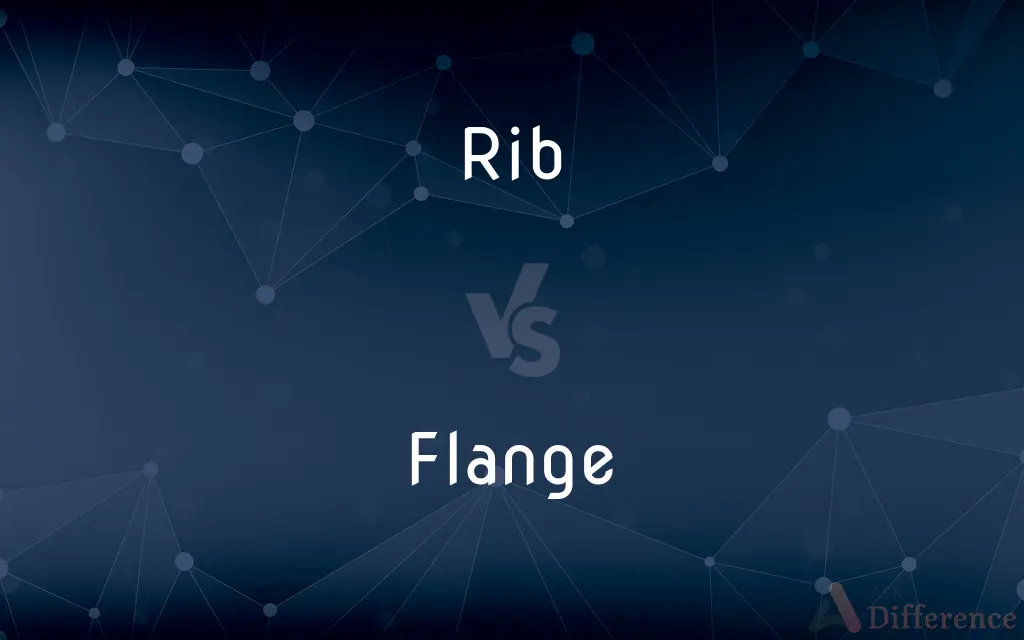Rib vs. Flange — What's the Difference?
By Fiza Rafique & Urooj Arif — Updated on March 30, 2024
A rib provides structural support and reduces material in 3D objects, while a flange extends from an object for attachment or strength enhancement.

Difference Between Rib and Flange
Table of Contents
ADVERTISEMENT
Key Differences
A rib is an integral part of an object’s design, often found in plastic injection molding and metal casting, used to increase strength and stiffness with minimal material use. On the other hand, a flange is a protruding ridge, lip, or rim, typically used to strengthen an object, provide a mounting mechanism, or ensure alignment between parts.
Ribs are usually internal features that are not visible from the outside of a product, making them ideal for internal reinforcement without altering the object's external aesthetics. Whereas flanges are external features that can be easily seen and are often used for connections, such as in pipes, where they allow for bolting two sections together.
The design and placement of ribs require careful consideration to avoid creating stress concentrations or warping, especially in plastic parts. Meanwhile, flanges must be designed to withstand the loads they will encounter, including tension, compression, or torsional forces, and their impact on the overall design is more straightforward.
In terms of manufacturing, adding ribs to a part can complicate the mold design and increase the cost, but it results in lighter, stronger parts. Flanges, however, might increase the material requirement but simplify the assembly process by providing straightforward attachment points.
Ribs often serve a dual purpose of enhancing structural integrity while aiding in material distribution within a mold, leading to better quality parts with fewer defects. Flanges, in contrast, primarily focus on providing a method for mechanical assembly or enhancing the structural connection between components.
ADVERTISEMENT
Comparison Chart
Purpose
Increases structural strength and stiffness with minimal material.
Provides attachment points, enhances strength, or ensures alignment.
Location
Internal, not visible from the outside.
External, easily seen and accessible.
Design Consideration
Must avoid stress concentrations; enhances part design without affecting aesthetics.
Designed to handle specific loads; affects aesthetics and functionality.
Manufacturing Impact
Complicates mold design but results in lighter, stronger parts.
Increases material usage but simplifies assembly.
Primary Function
Reinforcement and material distribution within a part.
Mechanical assembly and structural connection enhancement.
Compare with Definitions
Rib
A thin, raised strip of material added to an object to increase its strength.
The plastic chair's back had several ribs to support a person's weight.
Flange
An edge that extends from an object to add strength or stability.
The beam's flange was critical to the bridge's design.
Rib
An internal feature in casting or molding for structural support.
The designer included ribs in the smartphone case for added durability.
Flange
A projecting flat rim or collar used for attachment.
The pipe flange allowed for easy connection to the system.
Rib
A reinforcing element in structures or components.
Ribs in the airplane wing reduce weight while maintaining strength.
Flange
Features designed to handle specific loads, such as tension or compression.
The flange design accounted for the expected stresses during operation.
Rib
Used to minimize material and reduce weight without sacrificing performance.
The laptop's base featured ribs to keep it light yet sturdy.
Flange
Used in various mechanical parts for alignment or assembly.
The motor had a flange for secure mounting on the machine.
Rib
Designed to improve the flow of material during the molding process.
Ribs ensured the plastic filled the entire mold evenly, reducing defects.
Flange
A method to connect pipes, valves, and other equipment.
Flanges made it easy to dismantle the pipeline for maintenance.
Rib
In vertebrate anatomy, ribs (Latin: costae) are the long curved bones which form the rib cage, part of the axial skeleton. In most tetrapods, ribs surround the chest, enabling the lungs to expand and thus facilitate breathing by expanding the chest cavity.
Flange
A flange is a protruded ridge, lip or rim, either external or internal, that serves to increase strength (as the flange of an iron beam such as an I-beam or a T-beam); for easy attachment/transfer of contact force with another object (as the flange on the end of a pipe, steam cylinder, etc., or on the lens mount of a camera); or for stabilizing and guiding the movements of a machine or its parts (as the inside flange of a rail car or tram wheel, which keep the wheels from running off the rails). The term "flange" is also used for a kind of tool used to form flanges.
Rib
One of a series of long curved bones occurring in 12 pairs in humans and extending from the spine to or toward the sternum.
Flange
A protruding rim, edge, rib, or collar, as on a wheel or a pipe shaft, used to strengthen an object, hold it in place, or attach it to another object.
Rib
A similar bone in most vertebrates.
Flange
A wide edge on a pillow, placemat, or other fabric object, especially a piece of fabric or ribbon extending from the outer seam.
Rib
A part or piece similar to a rib and serving to shape or support
The rib of an umbrella.
Flange
An external or internal rib or rim, used either to add strength or to hold something in place.
Rib
A cut of meat enclosing one or more rib bones.
Flange
The projecting edge of a rigid or semi-rigid component.
Rib
(Nautical) One of many curved members attached to a boat or ship's keel and extending upward and outward to form the framework of the hull.
Flange
(RPG) An ability in a role-playing game which is not commonly available, overpowered or arbitrarily imposed by the referees.
Rib
One of many transverse pieces that provide an airplane wing with shape and strength.
Flange
The vulva.
Rib
(Architecture) A long, narrow, usually arched member projecting from the surface of a structure, especially such a member separating the webs of a vault.
Flange
The collective noun for a group of baboons.
Rib
A raised ridge or wale in knitted material or in cloth.
Flange
The electronic sound distortion produced by a flanger.
Rib
(Botany) The main vein or any of the prominent veins of a leaf or other plant organ.
Flange
(intransitive) To be bent into a flange.
Rib
(Slang) A teasing remark or action; a joke.
Flange
To make a flange on; to furnish with a flange; to bend (esp. sheet metal) in the form of a flange.
Rib
To shape, support, or provide with a rib or ribs.
Flange
To mix two copies of together, one delayed by a very short, slowly varying time.
Rib
To make with ridges or raised markings.
Flange
An external or internal rib, or rim, for strength, as the flange of an iron beam; or for a guide, as the flange of a car wheel (see Car wheel.); or for attachment to another object, as the flange on the end of a pipe, steam cylinder, etc.
Rib
(Informal) To tease or make fun of
Ribbed my friend about losing the game.
Flange
A plate or ring to form a rim at the end of a pipe when fastened to the pipe.
Rib
(anatomy) Any of a series of long curved bones occurring in 12 pairs in humans and other animals and extending from the spine to or toward the sternum.
Flange
To make a flange on; to furnish with a flange.
Rib
(by extension) A part or piece, similar to a rib, and serving to shape or support something.
Umbrella ribs
Flange
To be bent into a flange.
Rib
A cut of meat enclosing one or more rib bones.
Flange
A projection used for strength or for attaching to another object
Rib
(nautical) Any of several curved members attached to a ship's keel and extending upward and outward to form the framework of the hull.
Rib
(aeronautics) Any of several transverse pieces that provide an aircraft wing with shape and strength.
Rib
(architectural element) A long, narrow, usually arched member projecting from the surface of a structure, especially such a member separating the webs of a vault
Rib
(knitting) A raised ridge in knitted material or in cloth.
Rib
(botany) The main, or any of the prominent veins of a leaf.
Rib
A teasing joke.
Rib
A single strand of hair.
Rib
A stalk of celery.
Rib
A wife or woman.
Rib
(botany) Hound's-tongue (Cynoglossum officinale).
Rib
(botany) Costmary (Tanacetum balsamita).
Rib
(botany) Watercress (Nasturtium officinale).
Rib
To shape, support, or provide something with a rib or ribs.
Rib
To tease or make fun of someone in a good-natured way.
He always gets ribbed for his outrageous shirts.
Rib
To enclose, as if with ribs, and protect; to shut in.
Rib
(transitive) To leave strips of undisturbed ground between the furrows in ploughing (land).
Rib
One of the curved bones attached to the vertebral column and supporting the lateral walls of the thorax.
Rib
That which resembles a rib in form or use.
Rib
The chief nerve, or one of the chief nerves, of a leaf.
Rib
In Gothic vaulting, one of the primary members of the vault. These are strong arches, meeting and crossing one another, dividing the whole space into triangles, which are then filled by vaulted construction of lighter material. Hence, an imitation of one of these in wood, plaster, or the like.
Rib
Solid coal on the side of a gallery; solid ore in a vein.
Rib
A wife; - in allusion to Eve, as made out of Adam's rib.
How many have we known whose heads have been broken with their own rib.
Rib
To furnish with ribs; to form with rising lines and channels; as, to rib cloth.
Rib
To inclose, as with ribs, and protect; to shut in.
It [lead] were too grossTo rib her cerecloth in the obscure grave.
Rib
Support resembling the rib of an animal
Rib
Any of the 12 pairs of curved arches of bone extending from the spine to or toward the sternum in humans (and similar bones in most vertebrates)
Rib
Cut of meat including one or more ribs
Rib
A teasing remark
Rib
A riblike supporting or strengthening part of an animal or plant
Rib
A projecting molding on the underside of a vault or ceiling; may be ornamental or structural
Rib
Form vertical ribs by knitting;
A ribbed sweater
Rib
Subject to laughter or ridicule;
The satirists ridiculed the plans for a new opera house
The students poked fun at the inexperienced teacher
His former students roasted the professor at his 60th birthday
Common Curiosities
How do ribs affect the manufacturing process?
Ribs can complicate the mold design for a part, potentially increasing the cost, but they result in lighter, stronger parts by enhancing material distribution.
How do you design a rib to avoid weaknesses?
Designing ribs involves considering factors like thickness, location, and orientation to avoid stress concentrations and ensure even material flow.
What materials are flanges made from?
Flanges can be made from a variety of materials, including metals, plastics, and composites, depending on the application and the required strength.
What is a rib in design?
A rib is a thin, raised strip of material that is added to an object to increase its structural strength and stiffness, often used in plastic injection molding and metal casting.
What is the purpose of a flange?
A flange is used to provide attachment points, enhance the strength or stability of an object, or ensure alignment between different parts.
Can ribs improve the aesthetic appeal of a product?
In some designs, ribs can improve the aesthetic appeal by adding texture or patterns to the product, although this is not their primary function.
What is the difference between a rib and a beam?
A rib is a reinforcing feature typically found within a part or structure to add strength without much weight, while a beam is a structural element that primarily resists loads applied laterally to the beam's axis.
Can ribs be visible on a product?
While ribs are typically internal and not visible from the outside of a product, there are designs where ribs may also play an aesthetic role.
Do flanges add weight to a product?
Yes, flanges can add weight to a product due to the additional material required for their construction.
Is it possible to have both ribs and flanges on the same part?
Yes, a part can have both ribs and flanges, each serving different purposes such as internal reinforcement and external connections.
Are flanges only used in piping systems?
While flanges are commonly used in piping systems for connections, they are also used in various other applications requiring mechanical attachment or alignment.
How do ribs and flanges impact the cost of manufacturing?
Ribs can increase the complexity and cost of mold design, but reduce overall material usage, while flanges may increase material costs but simplify assembly and maintenance procedures.
Why are flanges important in industrial applications?
Flanges are crucial in industrial applications for creating secure, leak-proof connections between pipes, valves, and other components, facilitating easy assembly and maintenance.
Can the design of a flange affect its functionality?
Yes, the design of a flange, including its size, shape, and material, directly affects its functionality, strength, and compatibility with other parts.
How do ribs contribute to product durability?
Ribs contribute to product durability by increasing the structural integrity of parts, making them more resistant to bending, twisting, and breaking.
Share Your Discovery

Previous Comparison
Cupidity vs. Cupid
Next Comparison
Cuspid vs. CanineAuthor Spotlight
Written by
Fiza RafiqueFiza Rafique is a skilled content writer at AskDifference.com, where she meticulously refines and enhances written pieces. Drawing from her vast editorial expertise, Fiza ensures clarity, accuracy, and precision in every article. Passionate about language, she continually seeks to elevate the quality of content for readers worldwide.
Co-written by
Urooj ArifUrooj is a skilled content writer at Ask Difference, known for her exceptional ability to simplify complex topics into engaging and informative content. With a passion for research and a flair for clear, concise writing, she consistently delivers articles that resonate with our diverse audience.













































